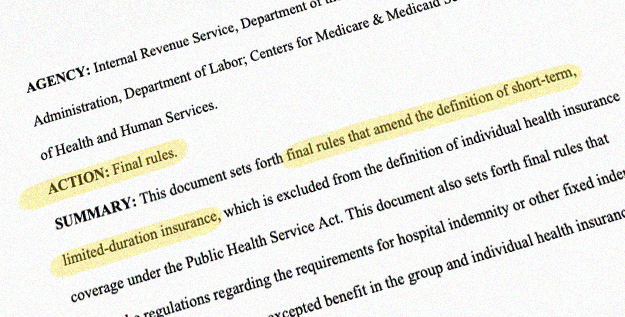
For the second time in 16 years, a sliver of the nation’s electorate, positioned in precisely the right states, cast votes with world-historic consequences. Were it not for various Democratic errors and late-inning intercessions by the FBI, Wikileaks, and Russian intelligence, I might now be writing a column lambasting President-elect Clinton for moving too slowly in repairing and expanding the Affordable Care Act (ACA). Instead we are pondering whether 20 million Americans will become uninsured. Such is the power of historical accident and contingent events to improve or to ruin millions of lives.
A useful reminder: ACA helped millions of people
President-elect Trump and congressional Republicans pledge to “repeal and replace” ACA. They control the right levers of federal power to do so, but they also face huge challenges. Probably the biggest barrier is also the simplest: ACA is now helping millions of Americans of every background and income.
Perhaps ACA’s most important beneficiaries have been those with costly health conditions. Individuals with preexisting conditions are protected through guaranteed-issue policies, the elimination of annual and lifetime caps on benefits, and Essential Health Benefit requirements, which mandate that health insurance actually covers customary treatments when people become ill.
All of these changes have made insurance more transparent and effective in case people got sick. They have also changed the business model of health insurers, who have a more difficult time making money by cherry-picking the healthy or by chasing away the sick in setting premiums or in benefit design. ACA also reduced gender discrimination by prohibiting gender disparities in pricing, and by covering contraception and other services pertinent to women’s health.
ACA improved population health by covering evidence-based clinical preventive services. This includes apple pie stuff such as mammographies and colonoscopies, and also less-glamorous but essential services such as screening for sexually transmitted infection. ACA did many other things too, including improved coverage for substance use and mental health disorders, and implementing important measures to promote patient safety and care quality. In 2008, none of the items in this paragraph would have particularly occasioned partisan divisions. The politics may be quite different moving forward, because all of these provisions are included in ACA.
Of course ACA also helped people of low and modest incomes. The new law has provided health insurance coverage to 20 million people who would have otherwise gone uninsured. Since 2011, 12.7 million fewer people report that their families are having trouble medical bills. ACA would have helped even more people, had large states such as Texas, Florida, and Georgia embraced Medicaid expansion.
State health insurance marketplaces have also assisted millions of consumers. Even after 2017 premium increases, 55 percent of marketplace participants have Silver-tier plans available to them for less than $75 per month.
Medicaid expansion: The jewel of health reform
ACA’s Medicaid expansion has been particularly successful in the states that embrace it. Virtually every large state outside the old Confederacy has expanded Medicaid, and these programs are working well. Indeed Medicaid expansion is probably the jewel of health reform.
Medicaid expansion has provided health coverage for millions of poor people across the nation. In both red and blue states, the expansion has also ameliorated some of the most appalling human failures of American healthcare.
A recent New York Times story by Sarah Varney recounts how Medicaid expansion has improved care for gunshot victims in cities such as Chicago and Detroit. Before ACA, about half of gunshot victims were uninsured. Now, most are insured through Medicaid or private coverage. Many uninsured gunshot wound victims spent months walking around with open skulls or with external colostomy bags because they couldn’t gain access to proper surgical and rehabilitation services. That rarely happens anymore, now that nearly all gunshot victims are covered.
Medicaid expansion has accomplished many other things, too. It shored up the safety-net care system by reducing the prevalence of uncompensated care. Since the federal government pays virtually the entire cost, Medicaid expansion has reduced fiscal burdens on state governments. It has strengthened the risk pool in state marketplaces by separating a particularly costly and complex group from the private insurance pool.
For the first time, we can plan a public health system knowing that nearly every patient has health insurance coverage, and thus the resources to finance safety-net care. My colleagues and I are embarked on two major trials of mental and behavioral health services here in Illinois for individuals who come into contact with the criminal justice system. We couldn’t do that without Medicaid expansion, because providers would have no secure way to get paid.
Medicaid expansion also allows states to coordinate health coverage with services for the disabled, education, housing, and more. It is precisely the sort of incremental bipartisan policymaking that Americans across the political spectrum would like to see occur. The Obama administration and ten Republican governors – including Vice President-elect Pence and Ohio governor John Kasich – have in some fashion negotiated in good faith to give politicians on both sides a dignified path to address human needs given the specific values and resources available in each state.
Indiana and Ohio’s Medicaid expansions look different from Massachusetts’ or California’s. I don’t particularly agree with everything conservative governors want to do. I won’t agree with every Medicaid waiver a Trump administration would approve, either. But that’s the give and take of normal American politics. Seema Verma, incoming leader of the Center for Medicare and Medicaid Services has participated in precisely such negotiations. There’s no reason, other than partisan politics, to alter this basic structure.
Ideologically moderate, fiscally disciplined policy …
ACA sought to combine the best Democratic and Republican ideas in an ideologically moderate, fiscally disciplined package. Perhaps that was the fundamental political error.
In so many ways, ACA was formulated and designed in accordance with the best principles of evidence-informed, ideologically pragmatic policymaking. Over many years, beginning well before Barack Obama ran for President, diverse stakeholders sought to combine the best Democratic and Republican ideas in an ideologically moderate, fiscally disciplined, and politically realistic market-based strategy to address obvious shortcomings of the health system.
Democrats tried for nearly a year, unsuccessfully, to negotiate Republican votes rather than ramming ACA’s main pillars through on a simple majority vote using the budget reconciliation process. I interviewed several Republican strategists in 2012 who believed the Democrats had made a strategic error by letting things drag out, and vowed to be more ruthless.
Of course ACA was modeled after Massachusetts’ Romneycare, a market-based approach rather than a more radical single-payer formulation. ACA cut the growth of Medicare provider payments. It included progressive taxes that extended the life of the Medicare trust fund. It did not include a “public option,” government price-bargaining for prescription medications, or other features progressive Democrats wanted. Through the complicated and unpopular “Cadillac tax,” ACA limited the tax subsidies granted to costly employer-supplied health plans, pursuing a goal quietly shared by almost every Democratic and Republican policy wonk (and almost no one else).
Because ACA’s framers wanted the market insurance to work, they offered consumers a diverse range of tiered plans, including some that allowed price-conscious consumers low monthly premiums in return for narrow provider networks, and heavy cost-sharing in the event of illness. It turns out that the marketplaces encouraged fierce price competition that favored such plans.
ACA also included various mechanisms to attract and protect private insurers similar to those implemented to stabilize the market for Medicare Advantage plans. States enjoyed tremendous latitude – then widened in 2012 by the Supreme Court – to establish their own regulated marketplace or to leave that responsibility to the federal government, to negotiate with the federal government to expand Medicaid, or not to expand Medicaid at all.
… and still attacked at every turn
Six years later, nearly every one of these efforts at ideological moderation and fiscal discipline brought real political costs. Many on the left disengaged because there was no public option. Many seniors embraced claims that ACA cut their benefits to finance coverage for less-worthy working-age adults. The fact that Republicans had spent decades expounding the need for entitlement reform was conveniently forgotten, now that seniors form the political base of the Republican Party.
Republicans attacked risk-based payments to marketplace insurers as a “bailout.” A bipartisan coalition that included unions and employers condemned ACA’s Cadillac tax. Although ACA did not increase the deficit, its opponents attack ACA as damaging the federal budget. Most Americans have no idea that ACA is costing substantially less than was predicted in 2010.
Although Democrats restrained the affordability tax credits, Republicans mounted precisely the same attacks on ACA as a trillion-dollar welfare program they would have had these credits cost substantially more. But the less-generous credits genuinely damaged the human marketplace experience for families with incomes above roughly 250 percent of the federal poverty level (above about $60,000 for a family of four), who faced pretty high premiums, but were eligible for pretty modest financial help.
When you combine that with provider consolidation and slower-than-usual but still positive medical care inflation, millions of middle-class families found marketplaces disappointing. For the first two years, the problem was contained as insurers charged modest premiums in the hope of gaining a foothold in this new market. Right on time for the presidential election, this year’s open enrollment included a median 16 percent rate hike, with much higher increases in key swing states.
The irony is palpable. Had the framers of ACA simply blown the budget by passing a bloated, fiscally-irresponsible middle-class entitlement, Hillary Clinton would probably have won.
Every budgetary “pay-for” in ACA is pretty unpopular, for the simple reason that there is no inherent constituency for deficit-reduction and controlling health care costs. Moreover, Republicans had clear incentives to make ACA fail. So they rejected efforts to fix ACA’s various imperfections and sought in many large and small ways to erode the quality of ACA’s implementation. Beyond that, Republicans sought with some success to undermine the marketplaces. There was even a fight in Republican primaries to claim credit for whom had done the most to undermine ACA marketplaces.
The looming human catastrophe of repeal
As I have written here, low-income people and people with chronic illnesses hugely benefit from ACA. Yet many are piled in the wrong places. are disorganized, or are otherwise not the voters one needs to politically prevail in America. Several million people who directly benefit from ACA voted for Republican candidates pledged to repeal it, either because these voters didn’t know ACA was helping them, or because they believed ACA is so embedded in the American fabric that it can’t be overturned.
Republicans will indeed have great difficulty unwinding ACA without causing a human catastrophe for which they would pay dearly. If Democrats paid a heavy political penalty for “owning” health policy in the Obama years, Republicans will pay a similar penalty if they damage things while they control all three branches of the federal government. As I’ve noted elsewhere, Republicans resemble the bear who caught the car. The car won’t emerge unscathed, but the bear will probably regret catching up. Although the electorate divides along partisan lines in their overall assessment of ACA, Americans support almost every individual element of ACA. There is no way to repeal it without doing unpopular things and visibly hurting real people along the way.
Rep. Price, secretary-designate of HHS, has proposed “repeal and replace” efforts that the Congressional Budget Office estimates would increase the number of uninsured by roughly 22 million. Urban Institute researchers find that “repeal” without replace would leave the health system in worse shape than it was before ACA, doubling the number of uninsured to as many as 58 million. Such a measure would lead many insurers to exit state marketplaces entirely. The absence of an individual mandate alone would do deep damage to the individual and small-group insurance market. One assumes that Republicans wouldn’t pursue such a politically self-immolating course, though after this election season one can never fully know.
Not surprisingly, nervous Republicans are seeking a safer way forward. Some are quietly discussing an abrupt reversal, trying to bolster state marketplaces by restoring the same risk-based marketplace payments to insurers they previously labeled “bailouts.” Republicans are trying to formulate a “repeal and delay” strategy that would triumphantly “repeal” ACA in 2019 or later, with a diffuse promise to replace ACA with something better.
That “something” remains largely unknown. There’s an obvious reason for that. If some politically painless strategy could cover the uninsured, control costs, lower the deficit, protect people with pre-existing conditions, and protect the core interests of hospitals, insurers, and other stakeholders in our $3 trillion medical economy, Democrats would have rushed to implement that instead of the messy compromises they negotiated to pass ACA. I suspect the main pillars of ACA will prove more durable than they seemed upon first word of the Trump victory.
A good deed, punished
What do we make of this long effort to enact near-universal health coverage? The ACA is a heartening human victory for millions of people. For that reason among others, if for no other, ACA will be politically difficult to undo.
I’m not proud of the political system that made ACA’s passage such an ugly ride, that in so many ways undermined the Act’s practical effectiveness, and that so deeply punished the President and his party who staked so much on this worthy effort. The ACA fight revealed large structural problems in our political system that won’t go away. The next time a politician wants to try something really big, to tackle some big national problem such as climate change or Social Security reform, her advisors might remind her of a President named Barack Obama, what he accomplished to insure millions of Americans, and what this effort really cost him. I fear the lessons she might draw from this experience.
But that’s for another day. For now, the political challenge brings a bracing clarity: to implacably resist the rollback of ACA. One must defend millions of people who might be hurt. This is a human imperative, and there are many political opportunities to be effective.
Ironically, Republicans themselves have shown the way. Since 2008, Republicans provided ample instructions on how a congressional minority might delay and obstruct a far larger majority and a far more popular president pursuing a far more popular agenda than we will see next year. Now Democrats are preparing to give the President-elect and Congressional Republicans an ample dose of the same medicine. As Macbeth once rightly worried: Bloody instructions, once taught, return to plague their inventors.
Harold Pollack is the Helen Ross Professor at the School of Social Service Administration. He is also Co-Director of The University of Chicago Crime Lab. He has published widely at the interface between poverty policy and public health. Pollack serves as a Fellow at the MacLean Center for Clinical Ethics at the University of Chicago, and as an Adjunct Fellow at the Century Foundation.









